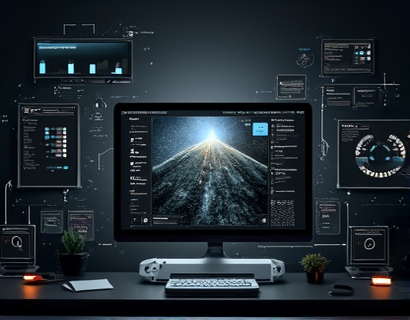Next-Gen Multi-Login Security: Simplify Digital Life with Advanced Online Authentication
In the digital age, managing multiple online accounts has become an everyday challenge. Each new service, application, or platform requires a unique set of credentials, leading to a proliferation of usernames and passwords. This not only complicates the user experience but also heightens the risk of security breaches. The need for a robust, user-friendly solution that simplifies managing these multiple logins while ensuring top-notch security has never been more critical. This article delves into the world of advanced online authentication, exploring how cutting-edge software solutions are revolutionizing the way we handle digital security.
Traditional methods of managing online accounts, such as keeping a spreadsheet or relying on memory, are no longer viable in today's complex digital landscape. The rise of phishing attacks, password breaches, and identity theft underscores the importance of a more sophisticated approach. Enter next-generation multi-login security solutions, designed to merge advanced security features with an intuitive user interface, providing a seamless and safe online experience.
Understanding the Need for Advanced Online Authentication
The primary goal of advanced online authentication is to provide a balance between security and convenience. As users, we demand easy access to our accounts across various devices and platforms, without compromising on the protection of our sensitive information. Traditional password-based systems fall short in this regard, as they are prone to vulnerabilities and often lead to user frustration due to the complexity of managing numerous passwords.
Advanced online authentication solutions address these issues by implementing multi-factor authentication (MFA), biometric verification, and secure token-based systems. These methods significantly reduce the risk of unauthorized access, ensuring that only the rightful owner can access the account. Moreover, they simplify the login process, making it more user-friendly and less prone to errors.
Key Features of Next-Gen Authentication Software
Next-generation authentication software encompasses a range of features designed to enhance both security and usability. Some of the key components include:
- Multi-Factor Authentication (MFA): This adds an extra layer of security by requiring more than one form of verification. Common methods include SMS codes, authenticator apps, and biometric data such as fingerprints or facial recognition.
- Biometric Verification: Utilizing unique biological traits, biometric verification offers a highly secure and convenient way to authenticate users. This method is increasingly being adopted by major platforms due to its reliability and user acceptance.
- Secure Token Generation: Tokens are temporary, one-time passwords generated by the software, which are valid for a short period. This ensures that even if a token is intercepted, it cannot be reused.
- Password Managers: Integrated password managers help users generate and store complex, unique passwords for each account, eliminating the need to remember multiple passwords.
- Single Sign-On (SSO): SSO allows users to access multiple applications or services with a single set of credentials, streamlining the login process and reducing the number of passwords needed.
- Behavioral Analytics: Advanced algorithms monitor user behavior to detect anomalies and potential security threats, providing an additional layer of protection.
These features collectively create a robust security framework that not only protects user data but also enhances the overall user experience. By automating complex security processes, users can focus on their digital activities without the constant worry of managing multiple passwords.
Benefits of Advanced Online Authentication
The advantages of adopting advanced online authentication solutions are manifold. For individuals, the primary benefit is peace of mind. With a reliable system in place, users can enjoy a higher level of security, knowing that their personal and financial information is well-protected. This is particularly crucial in an era where data breaches and identity theft are increasingly common.
For businesses, the benefits extend to enhanced compliance with regulatory standards and improved customer trust. By implementing robust authentication measures, companies can demonstrate their commitment to data security, which is a significant factor in customer decision-making.
Additionally, advanced authentication solutions can lead to cost savings. Traditional password management practices often require significant resources for IT support and security measures. By automating and streamlining the authentication process, organizations can reduce these costs while improving overall security.
User Experience: Security Meets Convenience
One of the most significant advantages of next-gen authentication software is its ability to merge advanced security with a user-friendly interface. Gone are the days of cumbersome login processes and constant password resets. Modern solutions are designed to be intuitive and seamless, ensuring that users can access their accounts quickly and securely.
For instance, biometric verification provides a frictionless login experience, allowing users to authenticate with a simple fingerprint scan or facial recognition. This not only speeds up the process but also enhances security, as biometric data is unique to each individual.
Password managers integrated into the authentication system further simplify the experience. Users can generate strong, unique passwords for each account without the need to remember them. The password manager securely stores these credentials, making it easy to fill in login fields automatically.
Single Sign-On (SSO) takes convenience to the next level by enabling users to access multiple services with a single set of credentials. This reduces the number of login prompts and eliminates the need to manage multiple passwords, making the overall experience more streamlined and efficient.
Implementing Advanced Authentication: A Step-by-Step Guide
For organizations looking to implement advanced authentication solutions, here’s a step-by-step guide to get started:
- Assess Current Security Measures: Evaluate the existing authentication methods and identify vulnerabilities. This will help in determining the specific needs and requirements for the new system.
- Choose the Right Solution: Research and select an authentication software that aligns with your security goals and user needs. Consider factors such as MFA options, biometric support, and integration capabilities.
- Plan the Implementation: Develop a detailed implementation plan, including timelines, resource allocation, and training requirements. Ensure that all stakeholders are informed and involved in the process.
- Integrate the Solution: Work with the software provider to integrate the authentication solution into your existing systems. This may involve API integrations, configuration settings, and testing to ensure smooth operation.
- Train Users: Provide comprehensive training to all users to familiarize them with the new authentication process. This includes tutorials on using MFA, biometric verification, and the password manager.
- Monitor and Optimize: After implementation, continuously monitor the system for any issues or areas for improvement. Collect user feedback and make necessary adjustments to enhance both security and user experience.
By following these steps, organizations can successfully adopt advanced authentication solutions, thereby elevating their digital security posture and enhancing the user experience.
Future Trends in Multi-Login Security
The field of multi-login security is rapidly evolving, with several emerging trends poised to shape the future of online authentication:
- Artificial Intelligence (AI) and Machine Learning: AI-driven analytics will become more prevalent, enabling more accurate threat detection and personalized security measures.
- Decentralized Identity Management: Blockchain technology is being explored for decentralized identity solutions, offering greater control and security for users.
- Context-Aware Authentication: This approach considers various contextual factors such as location, device, and user behavior to dynamically adjust security measures.
- Enhanced Biometrics: Advances in biometric technology, such as behavioral biometrics and multi-modal biometrics, will provide more accurate and secure authentication methods.
- Zero-Trust Security: The zero-trust model, which assumes no inherent trust within or outside the network, will influence authentication practices, requiring continuous verification.
These trends indicate a shift towards more intelligent, adaptive, and user-centric authentication systems. As technology continues to advance, we can expect even more innovative solutions that further simplify and secure our digital lives.
Conclusion
In conclusion, next-generation multi-login security solutions represent a significant leap forward in digital security and user convenience. By integrating advanced authentication methods with a user-friendly interface, these solutions offer a comprehensive approach to protecting user data while ensuring a seamless online experience. As the digital landscape continues to evolve, the importance of robust authentication systems cannot be overstated. Embracing these advanced solutions is not just a matter of convenience but a necessity in today's threat-prone environment.










































